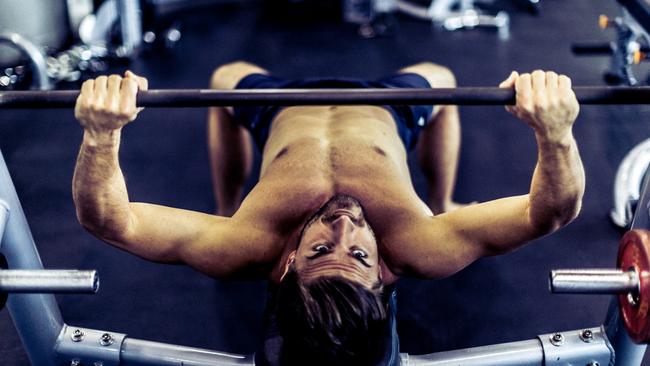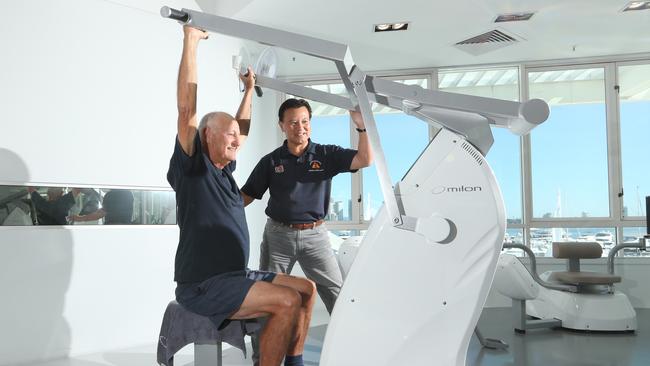How to spend half as much time lifting weights at the gym
While many believe lifting weights is key to increasing muscle strength and size, new research shows there is a more effective way.

What if you could lift weights for half the time and achieve exactly the same gains in strength? That could be entirely possible if you ditch lifting weights, and focus on lowering them.
New research by muscles guru Ken Nosaka from Edith Cowan University has found that the eccentric contraction – performed when the muscle is lengthened as when lowering weights – is the most effective for increasing muscle strength and muscle size.
“In the case of a dumbbell curl, many people may believe the lifting action provides the most benefit, or at least some benefit, but we found concentric muscle contractions contributed little to the training effects,” Professor Nosaka said.
Even better, the metabolic demands of lowering weights is less, so the effort feels easier for the body while delivering a bigger outcome. And for those disinclined to reach for the heavier dumbbells, minimal effort will still get you a result, according to Prof Nosaka.
“In order to increase muscle strength we know that we need to lift at 60 per cent of maximal strength in concentric contractions,” Prof Nosaka said. “But when we are doing eccentric contractions, even 30 per cent of your maximum strength is still enough. A much lower intensity of the contraction is still effective.”

Prof Nosaka has been obsessed with studying the eccentric muscle contraction ever since discovering that people performing muscle lengthening movements with weights felt sore after exercise, but those who focused on concentric contractions did not.
In this study, he teamed up with researchers from Niigata University and Nishi Kyushu University in Japan and Brazil’s Londrina State University, and had groups of people perform three different types of dumbbell curl exercise twice a week for five weeks. There was also a control group who did nothing.
Of the training groups, one performed eccentric-only muscle contractions (lowering weight), the other performed concentric-only muscle contractions (lifting weight) and another performed both concentric and eccentric muscle contractions (lifting and lowering weight alternatively). The eccentric-only group performed half the number of muscle contractions.
All three groups saw improvements in concentric strength, but this was the only improvement for the concentric-only group, whereas the eccentric-only and concentric-eccentric groups also saw significant improvements in isometric (static) muscle strength and eccentric strength.
And the eccentric-only group achieved equal strength gains to the other groups despite performing half the number of repetitions. Their muscles grew more in thickness than the other groups.

So why does the eccentric contraction appear to result in more gains in strength?
Prof Nosaka said there was no clear answer yet scientifically, but he believed the answer may lie in the apparent greater activation of the brain when lowering weights.
“Recruitment of the motor unit in the brain is important for increasing our strength,” Prof Nosaka said. “Eccentric contractions can activate the brain more. We need to control the weight more when lowering it which means the brain is more involved and the feedback system is activated more.
“Also when a muscle is lengthened muscle it is stretched, so signalling pathways activate, which mean the muscle produces more proteins.”
Prof Nosaka’s research is published in the European Journal of Applied Physiology.
Tips to cut your gym time in half
Arms: Using a dumbbell, use two hands to lift the weight up, and drop to using one arm to lower it. You can do this when performing: bicep curls, overhead extensions, front raises and shoulder presses.
Legs: Perform an eccentric squat by lowering slowly holding heavy weights by your sides. Drop the weights when coming up. You can perform the same technique in lunges.
Or get your strength gains without even leaving the house
Prof Nosaka said you did not need gym weights to apply his principles to a workout.
At home you can perform:
Chair sit: From a half-squatting position, sit down slowly on a chair in three seconds, (narrower and wider stances will create different effects). If this is easy, try to sit down with one leg.
Chair recline: Sit on the front of a chair to make a space between your back and the backrest, recline back slowly in three seconds (arms can be crossed at the chest or hold at the back of a head).
Uneven squat: Stand behind a chair, lean to one side to put more weight on one leg, then squat down in three seconds.
Heel down: Still behind a chair, lean forward and raise your heels. Then, lift one leg off the ground and lower the heel of the other leg in three seconds.
Wall kiss: Lean against a wall with both arms fully extended. Bend the elbow joint slowly over three seconds until your face gets close to the wall.
Front lunge: Place one leg in front of the other and bend the knees deeper over three seconds.






To join the conversation, please log in. Don't have an account? Register
Join the conversation, you are commenting as Logout